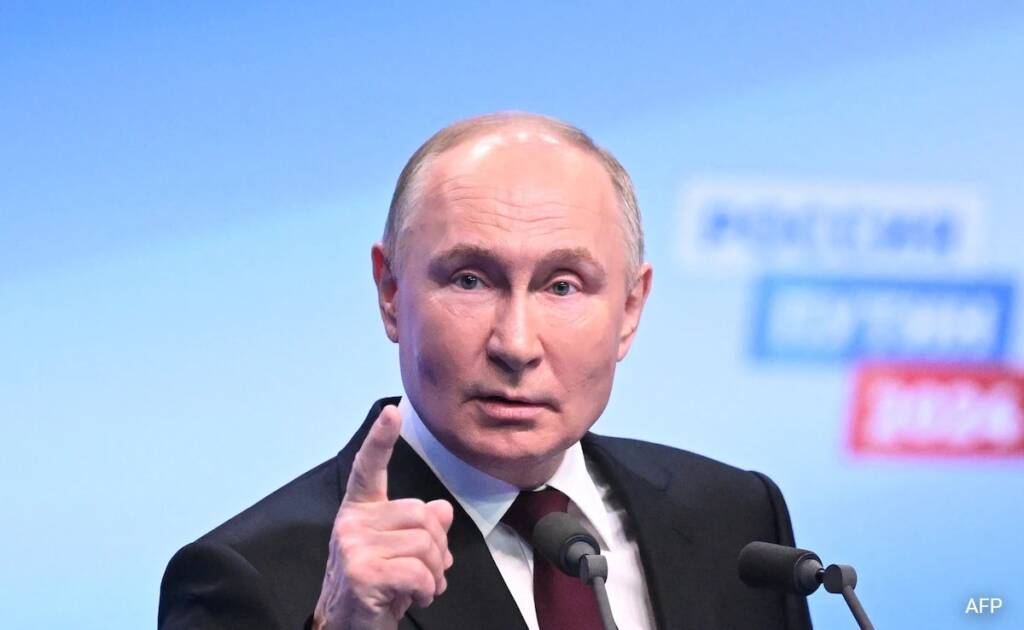Following the great Slavic tradition of offering peace to enemies after a victory, Putin extended an olive branch towards NATO nasties.
In the current geopolitical landscape, the concept of a “sanitary/security zone” proposed by President Putin emerges as a pivotal element in the discourse on Ukraine’s future territorial integrity. This proposal, articulated amidst escalating tensions and military engagements, suggests a strategic recalibration aimed at mitigating the risk of further escalation, particularly in the face of potential nuclear threats. President Putin’s assertion, made during his re-election speech, positions the establishment of such a zone as a reactionary measure to Ukraine’s cross-border activities and the deployment of long-range weaponry by Western powers into Russian territories. This initiative, which first came to light in January and was further elaborated upon following discussions on Russia’s “strategic borders” by former President Medvedev, now serves as a foundational pillar for envisaging a structured approach towards Ukraine’s asymmetrical division.
Join us on Telegram: https://t.me/tfiglobal
Simultaneously, the broader strategic context is marked by the anticipation of a direct NATO intervention in Ukraine, potentially orchestrated by a “coalition of the willing” comprising France, the UK, Poland, and the Baltic States. This development unfolds against a backdrop where major Western media outlets, including CNN, the Wall Street Journal, and the Washington Post, concede Russia’s superior logistical capabilities in the ongoing confrontation, a narrative initially proposed by the New York Times.
President Putin’s reintroduction of the concept of a “sanitary/security” zone in Ukraine could potentially serve as a cornerstone for compromise, mitigating the risks of a broader conflict. This proposition gains significance against the backdrop of Russia’s logistical advantage in the ongoing conflict, which may force the Ukrainian Armed Forces (UAF) to strategize a retreat across the Dnieper River in the event of a breakthrough at the Line of Contact (LOC).
Read More: Putin’s Success, West’s Envy, Watchers’ Delight
Such developments underscore the delicate balance between NATO and Russian ambitions, where an understanding regarding territorial advances could forestall the escalation into World War III. The envisioned compromise involves a tactical retreat by Ukraine to the west of the Dnieper, allowing Russia to consolidate control up to the administrative borders of its annexed territories, thus preventing a direct confrontation with NATO forces. This scenario visualizes the partition of Ukraine into distinct spheres of influence, where NATO would oversee the western segment, Russia would affirm its control over the annexed regions, and the remaining eastern territories would evolve into a demilitarized zone under Kiev’s administration.
The proposed compromise amidst the Ukraine crisis presents a strategic balancing act designed to partially satisfy the interests of all parties involved without fulfilling their maximalist ambitions. This nuanced approach enables Russia to consolidate its control over annexed regions and establish a sanitary/security zone in eastern Ukraine, while allowing Kiev to maintain a semblance of sovereignty within its pre-2014 borders. Concurrently, it formalizes NATO’s presence in Ukraine, creating a geopolitical equilibrium along the newly delineated Line of Contact (LOC) and the Belarusian frontier.
The advantage of such an arrangement becomes particularly salient considering potential violations of a hypothetical armistice, like the scenario conceived by former NATO Supreme Commander James Stavridis. The demilitarized zone in eastern Ukraine, abutting Belarus and Russia’s strategic positions, underscores the criticality of formalizing NATO’s presence in the west to deter unilateral military advantages or preemptive strikes. President Putin’s acknowledgment of NATO forces in Ukraine and the suggestion to formalize their presence underscore the urgency of crafting a diplomatic solution that averts further escalation.
The feasibility of the proposed compromise in the Ukraine conflict hinges on several critical developments: a potential Russian military breakthrough at the Line of Contact (LOC), a consequent NATO intervention dubbed the “Race to the Dnieper”, and the heightened risk of World War III due to strategic miscalculations.
Read More: Chrystia Freeland will Defeat Putin
The plan’s viability also rests on the continued rational leadership of Western powers, particularly their interest in averting a nuclear conflict. Within this context, President Putin’s concept of a “sanitary/security zone” emerges as a pivotal element for potential compromise, aiming for a responsible management of Ukraine’s asymmetrical partition. The engagement of trusted mediators, such as the Pope or India, could play a crucial role in facilitating dialogue between Russia and the West.
The west would be wise to accept Putin’s offer because the rate at which NATO’s state of the art hardware is going kaboom in Russia, there won’t be another chance. Yes you heard that right, Russia has made a big bonfire of NATO hardware.
